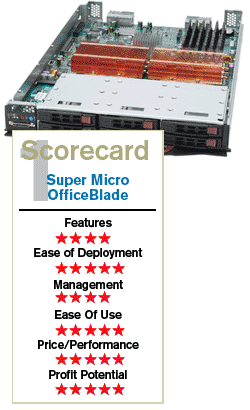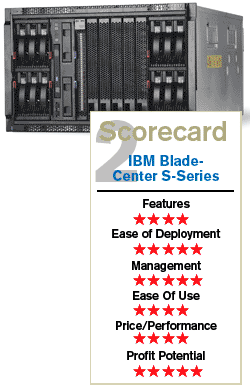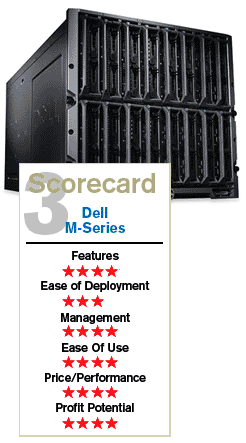Blades Of Glory
When CRN Test Center reviewers first set out to examine midmarket blade servers, much of the rhetoric in the space revolved around claims and counterclaims by giants IBM Corp. and Hewlett-Packard Co. Each company claimed to offer the best solution for midmarket blades, and the invective between the two was more heated than the racks of dense servers each could plug into a wall.
With all of the "anywhere, anytime" bravado IBM and HP had placed on the challenge of a head-to-head review, we invited both companies to participate. In the end, IBM took us up on the offer. HP was a no-show.
"Due to the success of our BladeSystem c-Class products in the marketplace, personnel who would normally work this review cannot be diverted from customer commitments," an HP spokesman told us.
But IBM didn't have to stand alone after all. We also invited Super Micro Computer Inc., Sun Microsystems Inc. and Dell Inc. to participate. Sun declined. Dell and Super Micro quickly accepted.
After examining all of the products, reviewers came to one conclusion: Each vendor provides a stellar offering that VARs can use to deliver strong value to midmarket customers. Each system provided screaming performance, nice energy efficiency and a self-contained chassis architecture. Each kept heat generation very low and ran much quieter than expected.
There were no rats' nests of wires. There were no malfunctions. What there was was a compelling reason for VARs to start talking to midmarket customers about their next-generation data centers and what a blade solution could do.
Next: Methodology Methodology
We asked each vendor to provide us with a blade system based on industry-standard CPUs and components, with no more than four servers each. We ran Microsoft Windows Server 2008 on each server. Other than meeting our routine electrical requirements, we then left it up to each vendor to configure a system that would take each metric in our methodology into consideration. A vendor might choose to focus all efforts on raw throughput performance, but the configured price could put it at a disadvantage over other systems. Or, a vendor could configure a system that was extremely easy to deploy and manage but take a hit from reviewers when it came time to evaluate performance.
Reviewers first used Geekbench 2.0 to test performance on each server in each blade system. We also included PassMark performance benchmarking, which we, in the end, decided might be more appropriate for 64-bit testing. Noise measurements were taken at startup and idling with a decibel meter. We took heat measurements after one hour of runtime and wattage measurements at startup and idling. Reviewers also judged failover capability, ease of deployment, management features and considered configured price, channel programs and VAR profit potential.
In the end, our group of reviewers wound up agreeing that Super Micro provided the best value based on a combination of all the factors we deemed relevant. IBM, we agreed, provided a stellar and valuable solution and a chassis design that appears second to none. Dell is very new to the blade server space, and the electrical limitations of our lab provided a minor challenge. But it was terrific from a performance standpoint and, if Dell is serious about working with the channel, could easily take a little share away from HP.
Next: Super Micro OfficeBlade Super Micro OfficeBlade
Super Micro provided us with a blade chassis and four two-way Intel Xeon L5420 processors, each at 2.5GHz and 8 Gbytes of memory. The system was built with four power supplies. It is a nifty, 7U-chassis design and the system itself is easy to take apart, put together, install and deploy. The servers scored an average of 6,530 using Geekbench's 32-bit testing, and 2,486.5 using Passmark's 64-bit performance testing. With all four blades operating, the system consumed 406 watts—nicely energy-efficient. It was quiet, too, producing 65 decibels of noise in the front and 69 decibels at the back. It was only slightly above the ambient noise in our lab, and it was much less quiet than our editors when we miss deadline.
The system also did well in thermal testing, producing 74 degrees Fahrenheit at the front and 77 degrees at the fan exhaust.

The browser-based management console is very intuitive. The menu, located down the left margin of the screen, contains seven tabs that cover everything necessary to manage the hardware, user access and virtual media, as well as configure all settings remotely. There is also a Maintenance tab where device info and event logs can be viewed. Configuring the unit via the console also is simple, with labels for each section and field. Every blade, switch and power supply is accessible with detailed information on individual power usage, temperature, fan speed, etc., and all hardware can be turned on, turned off or reset remotely.
Using the console's Java-based KVM is a breeze. After (or before) launching the KVM window by clicking on a link in the console, click the blade you want to control and select KVM. A blue LED on the front of the actual blade illuminates to show users in the data center which one is being remotely accessed.
Another easy-to-use feature is the ability to create virtual drives or redirect local drives for the blade to access. Using this function via the KVM, we were able to redirect the optical drive of our local PC to install the operating system on the blade, then we redirected our local hard drive and copied necessary testing files and programs over.
Of importance to solution providers is this: Super Micro allows for much customization to take place within a system and, by and large, solution providers can determine a great percentage of end-user pricing. Not only is this offering easy to install and control, but delivery, services and billing are just as easy.
Super Micro said the configured system is priced at $13,000 with four blades installed.
Next: The IBM BladeCenter S-Series The IBM BladeCenter S-Series
When the IBM blade solution arrived at our door, it scared us. It was packed inside a wooden crate that looked like a coffin straight out of a Bela Lugosi movie. Our group of reviewers took one look and braced for back pain. Much to our surprise, though, setup (including the lifting) was a breeze. With the servers removed, the elegant, locking black S-Series chassis is little more than 90 pounds and looks more like living room furniture than a serious computing solution.
But a serious computing solution it is. IBM provided its 7U chassis and blade servers with four different configurations: one with an Intel Core2 Duo E6405 at 2.13GHz and 2 Gbytes of RAM; one with dual, Intel Xeon E5450s at 3.0GHz and 4 Gbytes of RAM; one with dual Intel Xeon 5130s at 2.0GHz and 4 Gbytes of RAM; and one with dual Intel Xeon X3363s at 2.83GHz and 4 Gbytes of RAM. Its highest-performing blade, with dual Xeon E5450s, scored a far-out 7,429 on Geekbench and 2,929.4 on Passmark. If the system had been built spec'd out with four of those servers, its performance would have blown the roof off (but it may also have blown the roof off pricing, too).

With all four blades running, the S-Series consumed 705 watts of power. Its thermals ran to 77 degrees at the front of the system, 81 degrees at the exhaust fan. It was a very quiet system, too, throwing 69 decibels of noise with the back door closed and 78 decibels with it open. (We recommend keeping it closed.)
IBM's Advanced Management Module is extremely robust and browser-based. Similar to Super Micro's arrangement, AMM has a treelike configuration with six headings broken down into sections for monitoring and controlling the system remotely. The monitors give a wealth of information about everything from status to version numbers. The other sections cover user and file management and security, as well as allowing for individual control of the blades, switches, PSUs and any other related hardware in the chassis.
The console's layout permits users to access information with only one or two mouse clicks. After being selected from the menu in the left frame, the right frame displays the respective page with the top of the page containing hot links to the relevant section within that page.
Where appropriate, there are easy-to-read color and/or symbol notations that allow administrators to see at a glance the health of the particular system they are looking at.
The remote-control feature took a little time for our testers to get used to and, although it worked flawlessly, it had some slightly annoying shortcomings. Taking control of the remote server is done by simply clicking the mouse button while the cursor is on the remote desktop. To switch back to controlling the local computer, the user presses the Tab or Ctrl key. Reviewers found themselves again and again pressing the Tab key to switch fields only to find themselves dropping control of the server. In addition, to send the Ctrl-Alt-Del command (a necessity for logging onto most Windows operating systems), the user must tab out of the remote window, click an on-screen button and then click back into the remote screen.
At this configuration, IBM priced the system at slightly more than $27,000.
Next: Dell M-Series Dell M-Series
At 10U, the Dell M-Series chassis was the biggest we brought into the lab, but the system fit nicely into our data center.
It also was the only system that came built with six 208/220-volt power supplies (three online, three redundant in the configuration we tested). After calling in an electrician to install appropriate oblates in our lab to accommodate the power requirements, the M-Series installed and deployed very easily.

The system came with four dual Intel Xeon E5440 processors, each with 4 Gbytes of RAM. On Geekbench, it delivered an average score of 7,019, and on Passmark it came in, on average, at 2,761.3. Reviewers liked the even performance.
While running all four servers, the system consumed 1,112 watts of power, threw 70 decibels of noise from the front and 74 decibels at the back, and its thermals reached 80 degrees at the front and 86 degrees at the fan exhaust.
After logging onto the Chassis Management Controller, administrators can quickly navigate between server functionality by traversing tabs on the top of the Web page interface to configure the chassis. The left side of the CMC's Web page has a tree viewer to server components, including power supplies, temperature sensors and fans. CMC provides access to individual server controllers, Avocent iKVM switches and Gigabit Ethernet switches. To gain access to a server, administrators simply have to navigate to the console tab in the Integrated Dell Remote Access Controller and launch the viewer. Testers used the viewer to install Windows Server 2008 on each blade.
Dell provides an ActiveX control as well as a Java applet to access servers remotely. Dell also simplified the remote OS installation process by providing several remote boot-device options such as PXE and virtual media players so that administrators can build the servers without having to connect a local DVD or floppy drive.
One of the most prominent feature sets is the network security for the servers in the iDRAC user interface. In the Network/Security tab, administrators can integrate a server with Active Directory and even provide remote secured Web services such as SSH and Telnet.
Experienced engineers will find the documentation on most of the blades a hindrance. Once engineers are familiar with the external components of a blade server, they don't need to rely on the documentation to connect the servers. The Web interfaces provide enough information to install all the components. With four servers, the configuration price on this model runs to about $29,077, according to pricing on Dell.com.
Next: The Bottom Line Bottom Line
We can recommend each server for different reasons, but we liked the Super Micro the best. VARs can be confident in examining each vendor as a potential partner in delivering a blade solution to a midmarket customer.
Four Key Players
in Midmarket Blade Servers
COMPANY:
Dell
\
Round Rock, Texas.
\
(512) 338-4400
\
\
\
KEY PRODUCT:
Dell PowerEdge M600.
\
\
CHANNEL POINTS:
Dell offers deal registration, lead generation, generation, discounts, marketing assistance, enhanced parts replacement and partner
as part of its PartnerDirect program.
COMPANY:
Hewlett-Packard Co.
\
Palo Alto, Calif.
\
(650) 857-1501
\
\
\
KEY PRODUCT:
ProLiant BL260c, HP BladeSystem c3000.
\
\
CHANNEL POINTS:
HP providess education, training and marketing support in its PartnerOne program, has developed "Blade Builder University," a one-day course on its technology, and provides a
tool in addition to financial incentives for VARs.
COMPANY:
IBM Corp.
\
Armonk, N.Y.
\
(914) 499-1900
\
\
\
KEY PRODUCT:
BladeCenter S Chassis, BladeCenter H Chassis, BladeCenter E Chassis, BladeCenter HT Chassis, BladeCenter HS 12, BladeCenter HS21 (extended memory), BladeCenter LS21, BladeCenter LS41.
\
\
CHANNEL POINTS:
The IBM PartnerWorld site offers a section dedicated to IBM BladeCenter. From here, partners can access resources such as IBM Express portfolio, which includes BladeCenter models targeted at SMBs; Know Your IBM
modules; BladeCenter sales tools and competitive marketing information.
COMPANY:
Super Micro Computer Inc.
\
San Jose, Calif.
\
(408) 503-8000
\
\
\
KEY PRODUCT:
DataCenterBlade, OfficeBlade, SuperBlade
\
\
CHANNEL POINTS:
Super Micro offers channel partners special promotions including seeding, spif, rebate and special discount programs. MDFs are customizable and flexible. The vendor also offers service with free live access to technical experts on the phone and Web free of charge. Partner
includes resources such as product images, ad templates and product configuration tools.